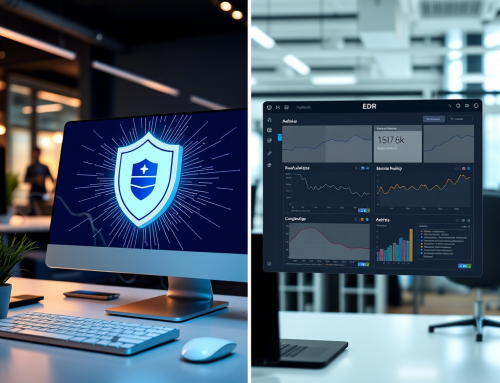The digital landscape continues to evolve at breakneck speed, and with it come new challenges and opportunities in cybersecurity. For IT professionals and technology enthusiasts, staying ahead of the curve isn’t just a matter of professional development—it’s essential for protecting businesses and individuals from increasingly sophisticated cyber threats.
This blog dives into the future of cybersecurity by highlighting key cybersecurity trends that are shaping how we safeguard systems, data, and infrastructure.
Why Staying Ahead Matters
2023 showcased some of the largest cyber attacks targeting supply chains, cloud systems, and SMBs (small to medium-sized businesses) in unprecedented ways. For those in the IT security field, preparation is no longer optional—it’s a daily necessity.
By keeping a pulse on these cybersecurity trends, IT professionals can protect sensitive information, minimize vulnerabilities, and adopt proactive measures to counteract evolving threats.
Top Cybersecurity Trends to Watch
1. Rise of AI-Powered Cyber Threats
Artificial intelligence (AI) isn’t just being used for good. Cybercriminals are leveraging AI to create malware that evolves and adapts, making traditional security measures ineffective.
- Trend alert: These “smart” cyber attacks can analyze patterns in IT systems and disguise themselves better than older malware types.
- What IT professionals can do: Invest in AI-driven cybersecurity tools capable of identifying and neutralizing threats in real time.
2. Zero Trust Security Architecture
The concept of “trust but verify” is shifting to verify everything, trust nothing. This zero trust model assumes every user, device, or system attempting to connect to a network could pose a risk.
- Why this matters: Many of the largest breaches in 2023 involved compromised credentials or insider threats. Zero trust architectures offer an additional layer of scrutiny.
- Actionable next step: Implement strong authentications like multi-factor authentication (MFA) to secure access at all levels, including privileged accounts.
3. Cloud Security Takes Center Stage
Cloud adoption is increasing, but so are targeted cloud attacks. Misconfigured cloud settings, lack of encryption, and shared responsibility gaps with providers have put businesses at greater risk.
- Trend spotlight: Gartner predicts that by 2025, 99% of cloud failures will be the customer’s fault due to mismanagement.
- What to do:
- Regularly audit cloud configurations.
- Train employees on shared responsibility models of cloud security.
- Leverage encryption tools for sensitive data stored in the cloud.
4. Emergence of Quantum Computing Risks
Quantum computing, while promising in revolutionizing computing power, poses a significant challenge for cryptography. Quantum attacks have the potential to render traditional encryption methods obsolete.
- Impact on cybersecurity:
- Widely used public-key encryptions could be vulnerable.
- Companies will need post-quantum encryption (PQE) strategies before quantum computers become mainstream.
- Call to action for IT professionals:
- Stay updated on advancements in cryptography.
- Begin exploring PQC (post-quantum cryptography) technologies.
5. Ransomware-as-a-Service (RaaS)
Ransomware attacks are becoming easier to execute thanks to Ransomware-as-a-Service platforms sold on the dark web. These pre-built kits lower entry barriers for wannabe hackers, making businesses of all sizes potential targets.
- Notable statistic: According to cybersecurity reports, ransomware groups earned over $1 billion in the past year alone.
- How to mitigate the risk:
- Regularly backup critical systems and data.
- Train employees to recognize phishing schemes often used to deploy ransomware.
- Update and patch exposed vulnerabilities in operating systems and software.
6. Role of IoT (Internet of Things) Security
From smart thermostats to medical devices, more IoT devices connect to the internet than ever before. However, many of these devices lack robust security measures, leaving entry points in enterprise networks vulnerable.
- Future projection:
- IoT devices will surpass 75 billion by 2025.
- Without proper security protocols, IoT vulnerabilities could multiply dramatically.
- Essential strategies:
- Use firewalls to segment IoT devices from critical systems.
- Implement regular firmware updates for all connected devices.
7. Cybersecurity Skills Shortage and Automation Growth
The rising demand for cybersecurity professionals is outpacing supply, creating a global skills shortage. To fill this gap, businesses are turning to automation.
- Future insight:
- AI tools and automated workflows are reducing the burden on IT teams by handling repetitive tasks like threat detection and log analysis.
- Advice for IT enthusiasts:
- Upskilling in cybersecurity AI and automation will increase career opportunities.
- Businesses should combine automation with regular staff training for maximal efficiency.
Key Takeaways for IT Professionals
The future of cybersecurity is both exciting and challenging. Here’s how you can be prepared:
- Stay proactive—Threats are evolving. Adopt a mindset of continuous learning and technological adaptability.
- Invest in technology—AI-powered defense tools and zero trust systems will be critical to staying ahead.
- Collaborate—Cybersecurity isn’t a one-person job. Join communities, share knowledge, and stay connected with industry insights.
Cybersecurity is no longer just a specialized niche—it’s a driving force behind how entire businesses operate. From addressing AI-driven malware to navigating the risks of IoT and quantum computing, IT leaders and technology enthusiasts are on the frontlines of securing our increasingly digital world.
Want to learn more about cybersecurity or start using cutting-edge security solutions in your organization? Stay ahead of the curve by diving deeper into these trends.





